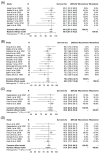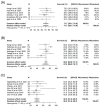Systematic Review and Meta-Analysis of Particle Beam Therapy versus Photon Radiotherapy for Skull Base Chordoma: TRP-Chordoma 2024
- PMID: 39061207
- PMCID: PMC11274426
- DOI: 10.3390/cancers16142569
Systematic Review and Meta-Analysis of Particle Beam Therapy versus Photon Radiotherapy for Skull Base Chordoma: TRP-Chordoma 2024
Abstract
[Objective] The aim of this study was to compare the efficacy of particle beam therapy (PT) with photon radiotherapy (RT) for treatment of skull base chordoma. [Methods] A systematic review was conducted for skull base chordoma treated with PT or photon RT reported from 1990 to 2022. Data were extracted for overall survival (OS) and progression-free survival (PFS), late adverse events, age, gender, gross total resection (GTR) rates, tumor volume, total irradiation dose, and treatment modality. Random-effects meta-regression analysis with the treatment modality as an explanatory variable was performed for each outcome to compare the modalities. [Results] A meta-analysis of 30 selected articles found 3- and 5-year OS rates for PT vs. photon RT or combined photon RT/proton beam therapy (PBT) of 90.8% (95% CI: 87.4-93.3%) vs. 89.5% (95% CI: 83.0-93.6%), p = 0.6543; 80.0% (95% CI: 75.7-83.6%) vs. 89.5% (95% CI: 83.0-93.6%), p = 0.6787. The 5-year PFS rates for PT vs. photon RT or photon RT/PBT were 67.8% (95% CI: 56.5-76.7%) vs. 40.2% (95% CI: 31.6-48.7%), p = 0.0004. A random-effects model revealed that the treatment modality (PT vs. photon RT or photon RT/PBT) was not a significant factor for 3-year OS (p = 0.42) and 5-year OS (p = 0.11), but was a significant factor for 5-year PFS (p < 0.0001). The rates of brain necrosis were 8-50% after PT and 0-4% after photon RT or photon RT/PBT. [Conclusion] This study shows that PT results in higher PFS compared to photon RT for skull base chordoma, but that there is a tendency for a higher incidence of brain necrosis with PT. Publication and analysis of further studies is needed to validate these findings.
Keywords: TRP; chordoma; meta-analysis; particle beam therapy; systematic review.
Conflict of interest statement
The authors declare no conflicts of interest.
Figures



References
-
- Bakker S.H., Jacobs W.C.H., Pondaag W., Gelderblom H., Nout R.A., Dijkstra P.D.S., Peul W.C., Vleggeert-Lankamp C.L.A. Chordoma: A systematic review of the epidemiology and clinical prognostic factors predicting progression-free and overall survival. Eur. Spine J. 2018;27:3043–3058. doi: 10.1007/s00586-018-5764-0. - DOI - PubMed
-
- National Comprehensive Cancer Network NCCN Clinical Practice Guidelines in Oncology: Bone Cancer (Version 1.2024) [(accessed on 23 March 2024)]. Available online: https://www.nccn.org/professionals/physician_gls/pdf/bone.pdf.
-
- Bai J., Li M., Shi J., Jing L., Zhai Y., Zhang S., Wang J., Zhao P., Li C., Gui S., et al. Mid-term follow-up surgical results in 284 cases of clival chordomas: The risk factors for outcome and tumor recurrence. Neurosurg. Rev. 2022;45:1451–1462. doi: 10.1007/s10143-021-01576-4. - DOI - PMC - PubMed
Publication types
Grants and funding
LinkOut - more resources
Full Text Sources

